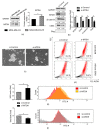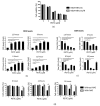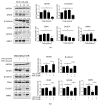Phenethyl Isothiocyanate Suppresses Stemness in the Chemo- and Radio-Resistant Triple-Negative Breast Cancer Cell Line MDA-MB-231/IR Via Downregulation of Metadherin
- PMID: 31979093
- PMCID: PMC7072670
- DOI: 10.3390/cancers12020268
Phenethyl Isothiocyanate Suppresses Stemness in the Chemo- and Radio-Resistant Triple-Negative Breast Cancer Cell Line MDA-MB-231/IR Via Downregulation of Metadherin
Abstract
Resistance to chemotherapy and radiation therapy is considered a major therapeutic barrier in breast cancer. Cancer stem cells (CSCs) play a prominent role in chemo and radiotherapy resistance. The established chemo and radio-resistant triple-negative breast cancer (TNBC) cell line MDA-MB-231/IR displays greater CSC characteristics than the parental MDA-MB-231 cells. Escalating evidence demonstrates that metadherin (MTDH) is associated with a number of cancer signaling pathways as well as breast cancer therapy resistance, making it an attractive therapeutic target. Kaplan-Meier plot analysis revealed a correlation between higher levels of MTDH and shorter lifetimes in breast cancer and TNBC patients. Moreover, there was a positive correlation between the MTDH and CD44 expression levels in The Cancer Genome Atlas breast cancer database. We demonstrate that MTDH plays a pivotal role in the regulation of stemness in MDA-MB-231/IR cells. Knockdown of MTDH in MDA-MB-231/IR cells resulted in a reduction in the CSC population, aldehyde dehydrogenase activity, and major CSC markers, including β-catenin, CD44+, and Slug. In addition, MTDH knockdown increased reactive oxygen species (ROS) levels in MDA-MB-231/IR cells. We found that phenethyl isothiocyanate (PEITC), a well-known pro-oxidant phytochemical, suppressed stemness in MDA-MB-231/IR cells through ROS modulation via the downregulation of MTDH. Co-treatment of PEITC and N-Acetylcysteine (a ROS scavenger) caused alterations in PEITC induced cell death and CSC markers. Moreover, PEITC regulated MTDH expression at the post-transcriptional level, which was confirmed using cycloheximide, a protein synthesis inhibitor.
Keywords: cancer stem cells; metadherin; phenethyl isothiocyanate; reactive oxygen species; resistance.
Conflict of interest statement
The authors declare no conflict of interest. The funders had no role in the design of the study; in the collection, analyses, or interpretation of data; in the writing of the manuscript, or in the decision to publish the results.
Figures








Similar articles
-
Ampelopsin Suppresses Stem Cell Properties Accompanied by Attenuation of Oxidative Phosphorylation in Chemo- and Radio-Resistant MDA-MB-231 Breast Cancer Cells.Pharmaceuticals (Basel). 2021 Aug 12;14(8):794. doi: 10.3390/ph14080794. Pharmaceuticals (Basel). 2021. PMID: 34451892 Free PMC article.
-
AMPK inhibits MTDH expression via GSK3β and SIRT1 activation: potential role in triple negative breast cancer cell proliferation.FEBS J. 2015 Oct;282(20):3971-85. doi: 10.1111/febs.13391. Epub 2015 Aug 20. FEBS J. 2015. PMID: 26236947
-
Baicalein Suppresses Stem Cell-Like Characteristics in Radio- and Chemoresistant MDA-MB-231 Human Breast Cancer Cells through Up-Regulation of IFIT2.Nutrients. 2019 Mar 14;11(3):624. doi: 10.3390/nu11030624. Nutrients. 2019. PMID: 30875792 Free PMC article.
-
Metadherin: A Therapeutic Target in Multiple Cancers.Front Oncol. 2019 May 3;9:349. doi: 10.3389/fonc.2019.00349. eCollection 2019. Front Oncol. 2019. PMID: 31131259 Free PMC article. Review.
-
Metadherin regulates epithelial-mesenchymal transition in carcinoma.Onco Targets Ther. 2016 Apr 21;9:2429-36. doi: 10.2147/OTT.S104556. eCollection 2016. Onco Targets Ther. 2016. PMID: 27143938 Free PMC article. Review.
Cited by
-
Reviewing the Prospective Pharmacological Potential of Isothiocyanates in Fight against Female-Specific Cancers.Cancers (Basel). 2023 Apr 20;15(8):2390. doi: 10.3390/cancers15082390. Cancers (Basel). 2023. PMID: 37190316 Free PMC article. Review.
-
Anticarcinogenic Effects of Isothiocyanates on Hepatocellular Carcinoma.Int J Mol Sci. 2022 Nov 10;23(22):13834. doi: 10.3390/ijms232213834. Int J Mol Sci. 2022. PMID: 36430307 Free PMC article. Review.
-
Antioxidant activity of banana flesh and antiproliferative effect on breast and pancreatic cancer cells.Food Sci Nutr. 2022 Jan 26;10(3):740-750. doi: 10.1002/fsn3.2702. eCollection 2022 Mar. Food Sci Nutr. 2022. PMID: 35311172 Free PMC article.
-
Emerging agents that target signaling pathways to eradicate colorectal cancer stem cells.Cancer Commun (Lond). 2021 Dec;41(12):1275-1313. doi: 10.1002/cac2.12235. Epub 2021 Nov 17. Cancer Commun (Lond). 2021. PMID: 34791817 Free PMC article. Review.
-
The Breast Cancer Stem Cells Traits and Drug Resistance.Front Pharmacol. 2021 Jan 28;11:599965. doi: 10.3389/fphar.2020.599965. eCollection 2020. Front Pharmacol. 2021. PMID: 33584277 Free PMC article. Review.
References
Grants and funding
LinkOut - more resources
Full Text Sources
Research Materials
Miscellaneous

